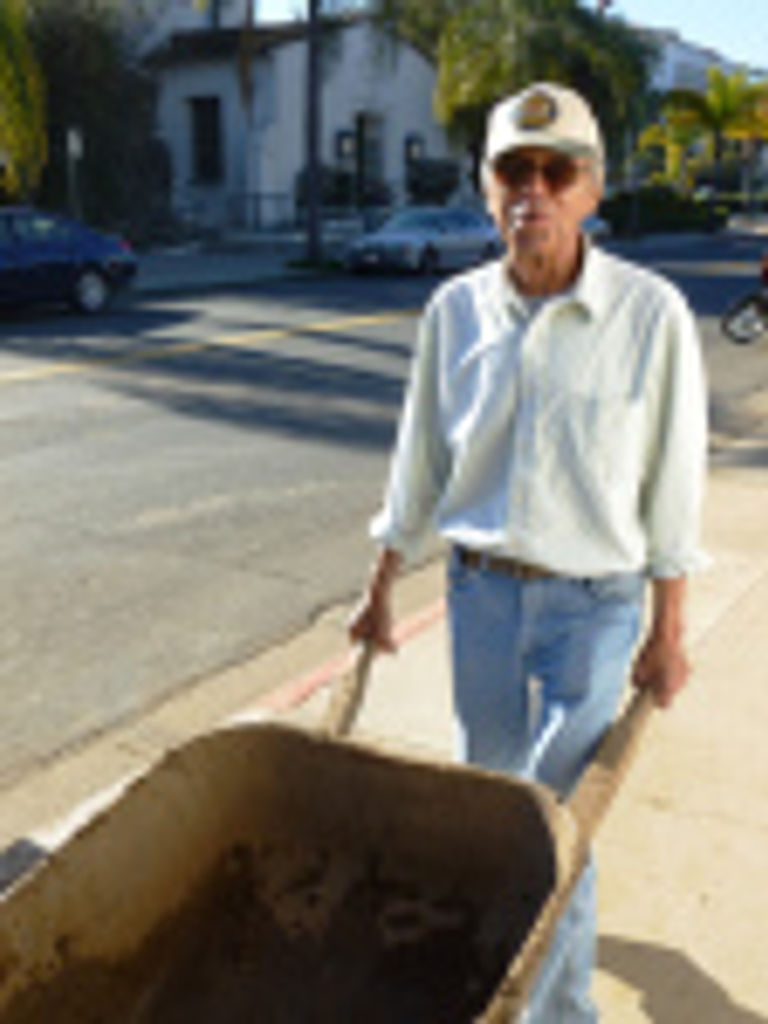by Mike Imwalle

Josh Figueroa sifting dirt for adobe brick making. Photo by Mike Imwalle.
During the week before Christmas, SBTHP director and maestro adobero Tim Aguilar began preparing the Presidio site for making a large batch of adobe bricks for the reconstruction of the Northwest Corner defense wall. Crews immediately began sifting dirt for the adobe mixture and grading the site flat for laying out the bricks. As soon as enough soil was prepared, crews began the process of mixing shovels of sifted dirt, water, straw, and a small amount of emulsified asphalt stabilizer.

The mixer crew adding shovels of dirt, water, and straw to the mixer. Photo by Mike Imwalle.
The site of the actual brick making is prepared in advance by laying out a series of wooden molds end to end and moistening them with water. The molds are constantly kept wet to prevent the thick mixture of mud and straw from sticking to the sides. Each mold has three rectangular reservoirs that will produce three 22 x 11 x 4-inch adobe blocks. The mud is delivered to the molds via wheelbarrows and dumped on to the surface of the molds.

SBTHP Director Tim Aguilar delivering a load of mud to the "punchers." Photo by Mike Imwalle.
The “punchers” scoop the excess mud out of the wheelbarrows and distribute it across the gang of three molds. Then, using their fists, they punch the mud deep down into the corners of the mold. This is a very important process to insure uniform size and good quality bricks with square corners. Once the mud is punched into the molds the excess mud is scraped even with the top of the mold and the surface of the brick is smoothed by hand. The mold is lifted off the bricks and moved down to the end of the line to make another batch. Soon the site is covered with freshly made adobes ready to begin drying in the sun.

Punching and smoothing the adobe into the wooden molds. Photo by Mike Imwalle.
After laying flat for three or four days the bricks are tilted up on their side to maximize the amount of surfaces exposed to the air. This insures nice even drying and prevents cracking caused by the exterior of the brick drying faster than the center. After about a week of making bricks the entire site is covered, and we need to take a break to let them dry for about a month before we can stack them.

Lifting the molds off the adobe bricks. Photo by Mike Imwalle.
It is nice to have bricks all over site again. Brick making always generates excitement around the park and interest from the public.

Freshly made bricks spread across the front of the Presidio. Photo by Mike Imwalle.
I will be discussing more detailed aspects of adobe in future posts, including a closer look at the ingredients of adobe bricks, adobe construction, and the use of adobe bricks during construction of the original Presidio quadrangle.

Bricks tilted up on their sides to dry in the sun. Photo by Mike Imwalle.
Anyone interested in participating in an adobe brick making event please contact Meredith Brockriede at meredith@sbthp.org to volunteer. If you are interested in supporting the Northwest Corner Reconstruction Project, visit the Buy-a-Brick campaign webpage here.
Mike Imwalle is the archaeologist at the Santa Barbara Trust for Historic Preservation.


Comentarios